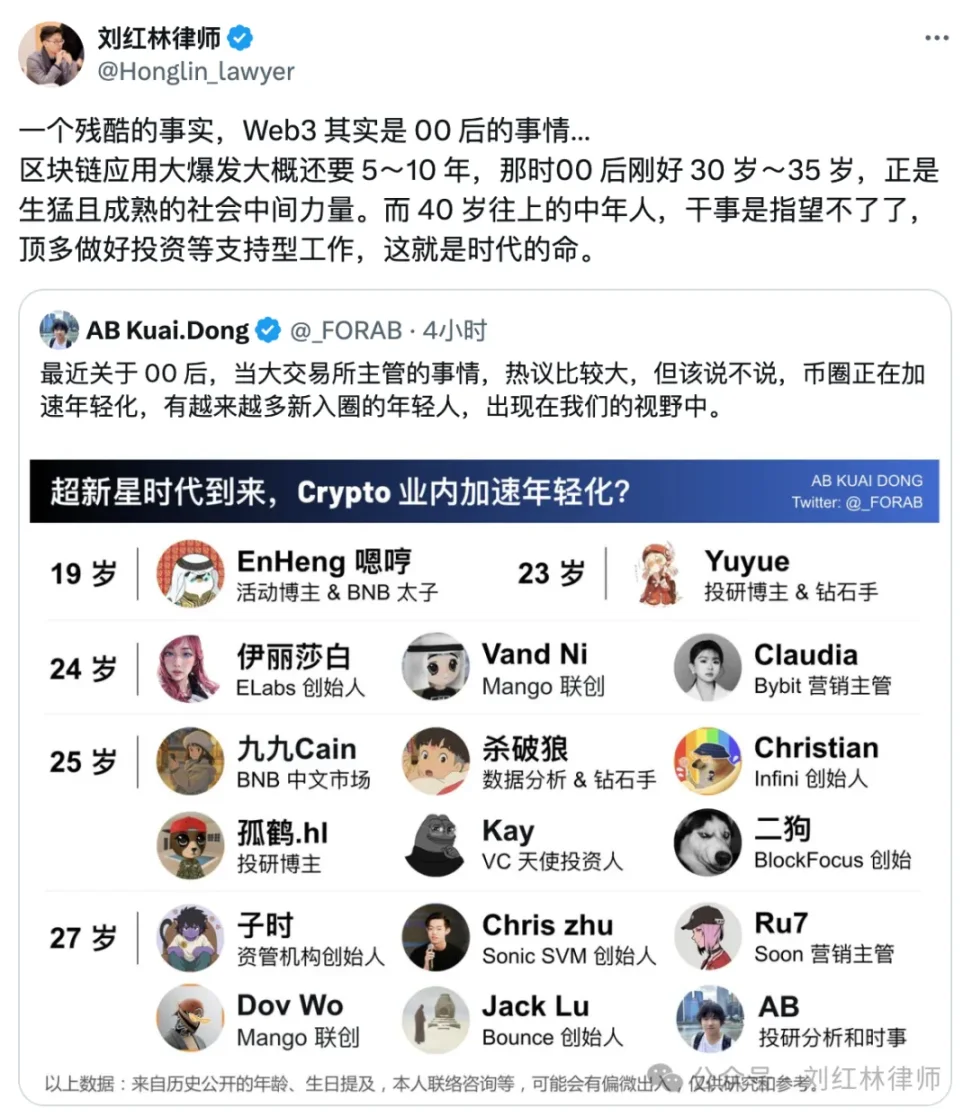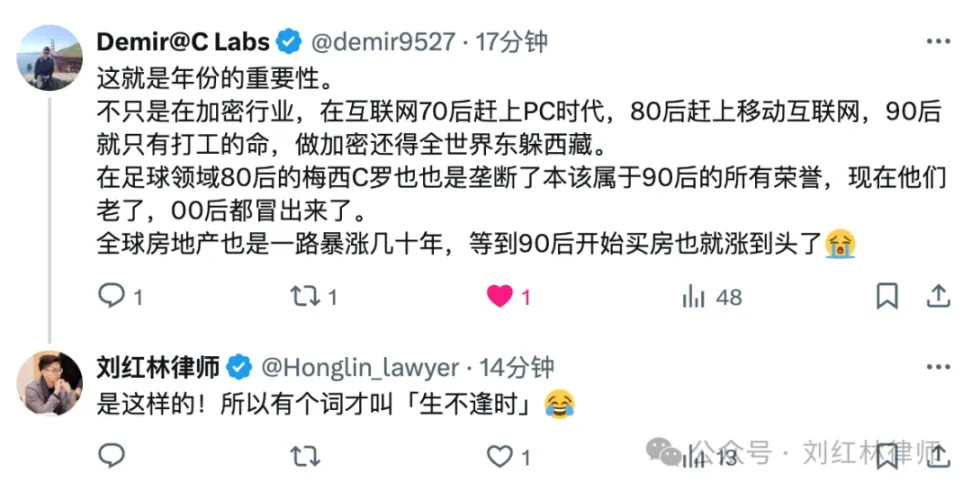Author: Liu Honglin
In the crypto industry, "youth" is no longer a label, but a reality.
When Lawyer Honglin was surfing the Internet, he saw a list of "Young Faces in the Crypto Industry" circulating on social media. From BNB, SVM to Infini, from researchers to VCs, from exchange operators to Meme community founders, all of them were young people in their twenties. The youngest was 19 years old, and the oldest was no more than 27 years old. They are not only the spokespersons of the project, but also the leaders of the narrative, the organizers of the circle, and even the dispatchers of capital.
Lawyer Hong Lin sighed: "A cruel fact is that Web3 is actually a thing for the post-00s..."

Why did the "young people" win this game?
This is not an emotional sigh, but a calm and serious time deduction. According to the current unsatisfactory development progress of the industry (especially the Ethereum stablecoin project), if the blockchain industry really wants to usher in a big explosion of applications, it will take another 5 to 10 years to be optimistic. At that time, the post-00s will be 30 to 35 years old, which is the golden age of vigor and maturity with both technical and resource strength. What about the post-80s and post-90s? Most of them have passed the stage of being able to fight, both physically and mentally. If you still want to do something in the industry, you will probably have to transform into an investor, or contribute to the workplace Werewolf Killing Zhen Huan Zhuan with years of experience, and the opportunities left for them to charge into battle are getting fewer and fewer.
The reason is that today’s Web3 is no longer an industry where you win a seat by experience, but by voice, community perception, and information sensitivity. And these are often not in the hands of the elderly.
The young people on the list have almost no labels of "traditional finance" or "internet giants". You can interpret this as a lack of social experience, but you can also say that they have no path dependence and toxic stock. They did not switch from Web2 to Web3, but were directly "born on the chain". For this generation of young people, Web3 is not a transformation, but a job.
They have been investing in projects, becoming KOLs, and building communities since college. Their understanding of the rules of the game, marketing techniques, data rhythm, and ecological linkage on the chain far exceeds that of the "old drivers". They have no baggage, have their own discourse system, dare to speak and try, and are even willing to charge forward and step on landmines. This generation's technical capabilities and market sense are truly native "chain species".
More importantly, a new trust system and collaboration method has been formed between them. It is not based on the "mentor-apprentice system" or "platform transfusion", but on the circle of friends, TG groups, RedBook dynamics, and the meme culture of constantly changing narratives. This kind of cooperation method is difficult for the elderly to integrate into, or even understand.
The old generation of Web3 practitioners: the fate of passive "overtime"
If you are a Web3 practitioner born in the 1980s or 1990s, you may have felt a little tired in recent years: bull markets come one after another, and the technical narrative has shifted from Layer 1 to RWA and then to AI+Crypto. The pace is somewhat like the howling of monkeys in the sky.
You may have done a lot of "structurally correct" things, such as launching chains, making wallets, setting up guilds, and managing funds, but looking back, what really won the market were the airdrop bots, token intelligence analysis, and diamond hand communities created by a 23-year-old graduate student while attending classes.
It's not that you don't work hard, but that the rhythm is wrong. In today's Web3 world, speed is better than scale, traffic is better than foundation, and rhetoric is better than experience. This is not a question of right or wrong, but the rules have changed.
Crypto's technology development is becoming more modular and product-oriented, and the reliance on "elite developers" is decreasing; while the complexity of community, traffic, and token economic design is increasing. Narratives are becoming faster, popularity is shorter, project life cycles are compressed, and the importance of operations and gaming strategies is increasing.
This means that the industry's requirements for people have changed, from "being able to do" to "being able to express"; from "technical" to "responsive"; from "accumulating assets" to "creating emotions".
In such an environment, the advantage of being young is not that they are “cheap”, but that they have shorter feedback cycles, less path dependence, and more flexible social operation methods. Their “first principles” are social networks, not white papers.
This is not the alienation of Web3, but what it really is: an experimental industry that puts community-driven and consensus-building first.
The biggest challenge facing middle-aged people is not lack of ability, but "too high participation cost". You can't stay up late to surf Discord anytime and anywhere, you can't fly three times a week to participate in ecological activities, and you can't turn social accounts into an extension of your life. At this time, you can only retreat to the second line, be an angel investor, do investment research, and talk about industry knowledge. This is actually the true meaning of lawyer Hong Lin's words "at most do a good job of investment support work".

Web3 old OG, how to pass the baton?
In 1961, the 26-year-old Li Ao wrote "Old People and Sticks" in Taipei, in which he cites a wide range of sources and uses a sharp style to question the predecessors in the intellectual circles at that time who "neither retired, nor took apprentices, and were unwilling to hand over the baton."
He said: "What young people fear most is not that you don't give them the stick, but that you hold an outdated stick and hit them on the head with it." This sentence spans sixty years, and when read today, it still sounds like an accurate naming of many "old leeks" and "old people in the circle" in the Web3 world.
When his generation wrote about Bangzi, they were writing about the intergenerational anxiety of academia, politics, and culture. Today, when we say "Bangzi in Crypto," we are talking about the real transfer of technical discourse power, traffic organization power, and community control. Bangzi is no longer an abstract "ideal" or "tradition," but the real influence of nodes, tokens, and industry circles.
In his article, Li Ao reminded the younger generation not to overestimate the elderly's "desire to inherit" - many people can't even hold the baton firmly, and what even more people hand over is just a hollow stick that has been hollowed out by time and only has a coating left.
They keep saying they support young people, but when it comes to allocating resources, launching projects, and voting, you will find that "support" is just a gesture, and the power is still in their pockets. "You propose, I make the decision; you operate, I sign; you charge, I '+1' in the group." The result is that you think you are relaying, but in fact you are just working.
So the question is never whether you are old or not, but whether you have the real awareness and ability to "pass the baton".
Don't forget that every generation of technological innovation has a group of "behind-the-scenes operators". They don't steal the spotlight, but they grab resources, control the pace, and reduce risks. Middle-aged people don't necessarily need to compete with the post-00s for traffic, but they can negotiate deals with them, allocate resources, and ensure the bottom line. You may not be able to be a 23-year-old content blogger, but you can invest in him, incubate him, and serve him, turning yourself into a lever and base for young people to exert their strength, and take the initiative to be the one who passes the baton.
The truly respectable “Crypto elders” are not those who stand in the middle of the stage pretending to be young, but those who stand behind the stage and let the young people really run. They are not those who tell the story of “my past”, but those who help them tell the story of “your present”. They are not those who grab the “next baton”, but those who make it easier for the “next baton” to take over, run faster, and take fewer detours.
After all, this trend is not about confrontation, but symbiosis.
This is not a drama of "young people replacing middle-aged people", but a structural change of the Web3 industry from "technology-led" to "narrative-led". And the first to perceive and adapt to this change are the new generation of practitioners who "pushed up at the age of 19, wrote contracts at the age of 23, and started projects at the age of 25".
They don't need us to teach them, but we have to learn to learn again.
This is the fate of the times.





